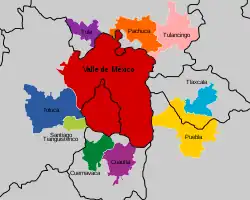Mexico City megalopolis
The Mexico City megalopolis, also known as the Megalopolis of Central Mexico (Spanish: Corona regional del centro de México), is a megalopolis containing Greater Mexico City and surrounding metropolitan areas.[1]

In 1996, the Programa General de Desarollo Urbano del Distrito Federal first proposed the concept of a "Megalopolis of Central Mexico", which was later expanded by PROAIRE, a metropolitan commission on the environment.[2]
The Megalopolis of Central Mexico (pre-2019 definition) includes 10 metropolitan areas of Mexico, as defined by the National Population Council (CONAPO): Valley of Mexico, Puebla, Toluca, Cuernavaca, Pachuca, Tlaxcala–Apizaco, Cuautla, Tulancingo, Tula and Tianguistenco.[3] Some of these areas form complex subregional rings themselves (i.e. Puebla forming a regional ring with Atlixco, San Martín Texmelucan, Tlaxcala and Apizaco).
The megalopolis (pre-2019 definition) spreads over 19,500 square kilometres (7,500 sq mi), and consists of 185 subdivisions in 6 federative entities: 169 municipalities, 81 in the State of Mexico, 39 in Tlaxcala, 19 in Puebla, 16 in Hidalgo, and 14 in Morelos; plus the 16 boroughs of Mexico City.[2] Its population as of 2020 is 30.8 million people, about 25% of the country's total.
Since 2019 the megalopolis (as defined by the Environmental Commission for the Megalopolis, CAMe) includes the state of Querétaro.[4][5] The Querétaro metropolitan area is also part of the fast-growing macroregion of Bajío.[6]
Component metropolitan areas
| Rank | Metropolitan Area | Federative Entity | Munic. | Area (km2) | 2020 Census[7] | 2010 Census[8] | Change |
|---|---|---|---|---|---|---|---|
| 1 | Valley of Mexico | Mexico City, State of Mexico, Hidalgo | 76 | 7,866.1 | 21,804,515 | 20,116,842 | +8.39% |
| 4 | Puebla | Puebla, Tlaxcala | 39 | 2,392.4 | 3,199,530 | 2,728,790 | +17.25% |
| 5 | Toluca | State of Mexico | 16 | 2,410.5 | 2,353,924 | 2,014,091 | +16.87% |
| 8 | Querétaro | Querétaro | 5 | 2,427.3 | 1,594,212 | 1,161,458 | +37.26% |
| 16 | Cuernavaca | Morelos | 8 | 1,189.9 | 1,028,589 | 924,964 | +11.20% |
| 32 | Pachuca | Hidalgo | 7 | 1,184.8 | 665,929 | 512,196 | +30.01% |
| 33 | Tlaxcala–Apizaco | Tlaxcala | 19 | 708.1 | 570,308 | 499,567 | +14.16% |
| 38 | Cuautla | Morelos | 6 | 979.6 | 483,455 | 434,147 | +11.36% |
| 56 | Tulancingo | Hidalgo | 3 | 673.1 | 268,351 | 239,579 | +12.01% |
| 59 | Tula | Hidalgo | 5 | 1,845.8 | 256,795 | 205,812 | +24.77% |
| 67 | Tianguistenco | State of Mexico | 6 | 304.0 | 183,281 | 157,944 | +16.04% |
| Mexico City megalopolis | 185 | 19,554.3 | 32,408,889 | 28,995,390 | +11.77% | ||
References
- The Transition to a Predominantly Urban World and its Underpinnings, p.14
- Área metropolitana del Valle de México PROAIRE
- "Delimitation of Mexico's Metropolitan Areas 2015" (in Spanish). CONAPO. Retrieved December 29, 2020.
- "Querétaro ya será parte de la megalópolis ('Querétaro will now be part of the megalopolis')". Diario de Querétaro. October 25, 2019. Retrieved August 20, 2023.
- Comisión Ambiental de la Megalópolis (September 2018). "La megalópolis de la ZMVM (The Greater Mexico City Megalopolis)". Gobierno de Mexico (Government of Mexico) (in Spanish). Comisión Ambiental de la Megalópolis. Retrieved August 20, 2023.
- "Megalópolis del centro del país", Effeta, June 2014
- "Censo de Población y Vivienda 2020 - SCITEL" (in Spanish). Retrieved Jan 26, 2021.
- "Censo de Población y Vivienda 2010 - Consulta" (in Spanish). INEGI. Retrieved Dec 11, 2020.